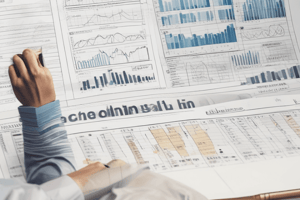Podcast
Questions and Answers
What determines how reports are accessed and who can view, edit, or manage them?
What determines how reports are accessed and who can view, edit, or manage them?
- Role
- Folder (correct)
- License type
- Report type
What is the primary purpose of choosing a report type?
What is the primary purpose of choosing a report type?
- To share the report with others
- To create a custom folder
- To control access to the report
- To select the records and fields available for the report (correct)
What is the benefit of creating custom report types?
What is the benefit of creating custom report types?
- To have access to all standard report types
- To make a report type public
- To create a standard report type
- To include specific objects and fields not available in standard report types (correct)
What is an example of a standard report type offered by Salesforce?
What is an example of a standard report type offered by Salesforce?
What is the purpose of a primary object in a report type?
What is the purpose of a primary object in a report type?
Who has access to a private folder?
Who has access to a private folder?
What is a report folder used for?
What is a report folder used for?
What is the result of selecting a custom report type named 'Leads with Activities'?
What is the result of selecting a custom report type named 'Leads with Activities'?
What is the first step in building a report?
What is the first step in building a report?
What is the role of Maria Jimenez in the story?
What is the role of Maria Jimenez in the story?
What is the primary purpose of a report?
What is the primary purpose of a report?
What did Maria do to the report after filtering and grouping the data?
What did Maria do to the report after filtering and grouping the data?
What is the outcome of Maria's report for Sita?
What is the outcome of Maria's report for Sita?
What is the main benefit of using reports and dashboards?
What is the main benefit of using reports and dashboards?
What is the result of Maria's filtering process?
What is the result of Maria's filtering process?
What can you do to the data in a report?
What can you do to the data in a report?
Flashcards are hidden until you start studying
Study Notes
### Study Notes: Implementing Reports and Dashboards in Salesforce
#### Learning Objectives:
- Understand the significance of reports and dashboards in Salesforce.
- Learn how to create and customize reports.
- Learn how to create and customize dashboards.
### Overview
#### Importance of Reports and Dashboards:
- Reports: Crucial for data analysis, they help in making informed business decisions by providing insights into various data points.
- Dashboards: Visual representations of report data, they offer a quick overview of key metrics and performance indicators.
### Steps to Implement Reports:
1. Accessing Reports:
- Navigate to the Reports tab in Salesforce.
2. Creating a New Report:
-
Click on New Report.
-
Select the report type that best fits the data you want to analyze.
-
Configure the report by adding filters, grouping data, and selecting the desired fields.
3. Customizing Report Formats:
-
Choose from various formats like tabular, summary, matrix, and joined reports.
-
Use report charts to visualize data.
4. Saving and Running Reports:
-
Save your report with a clear and descriptive name.
-
Run the report to view the data.
### Steps to Implement Dashboards:
1. Accessing Dashboards:
- Navigate to the Dashboards tab in Salesforce.
2. Creating a New Dashboard:
-
Click on New Dashboard.
-
Provide a name and description for the dashboard.
3. Adding Components to the Dashboard:
-
Click + Component to add a report chart or gauge.
-
Select the report you want to base the component on.
-
Customize the component settings, including the type (e.g., bar chart, pie chart).
4. Customizing Dashboard Layouts:
-
Drag and drop components to organize the dashboard layout.
-
Adjust the size of components to highlight critical data.
5. Setting Dashboard Filters:
- Add filters to view different slices of data without creating multiple dashboards.
6. Sharing Dashboards:
- Share dashboards with other users or groups to ensure everyone has access to critical information.
### Summary
Reports and dashboards in Salesforce are powerful tools for data analysis and visualization. By creating and customizing them, you can gain valuable insights into your business operations and performance, aiding in strategic decision-making.
For detailed instructions and hands-on practice, refer to the [Salesforce Trailhead module](https://trailhead.salesforce.com/content/learn/modules/lex_implementation_reports_dashboards/lex_implementation_reports_dashboards_overview?trailmix_creator_id=strailhead&trailmix_slug=prepare-for-your-ux-designer-credential).
Studying That Suits You
Use AI to generate personalized quizzes and flashcards to suit your learning preferences.




